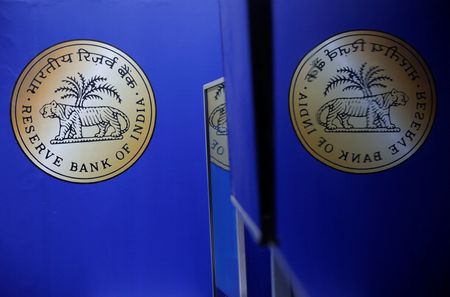By Swati Bhat and Ira Dugal
MUMBAI (Reuters) – The Reserve Bank of India’s board approved the transfer of 2.69 trillion rupees ($31.53 billion) as surplus to the federal government for the fiscal year ended March as it opted to raise its contingency risk buffer under a revised economic capital framework, it said on Friday.
The government had budgeted a dividend of 2.56 trillion rupees from the RBI, state-run banks and other financial institutions, according to budget estimates for the fiscal year 2025/26 in February.
Analysts’ estimates, however, had ranged between 2.7 trillion rupees and 4 trillion rupees. In fiscal year 2024, the RBI had transferred a surplus of 2.11 trillion rupees.
The lower-than-expected transfer follows a change in the range of contingency risk buffer that the central bank can maintain to 6% +/-1.5%. The buffer was to be maintained between 5.5% and 6.5% previously.
“We believe that the revision in ECF with hike in buffers to 6% +/-1.5% is very prudent during times of global and domestic economic uncertainty,” said Kanika Pasricha, chief economic adviser, Union Bank of India.
“With the number higher versus budgeted … the RBI has managed to provide fiscal leeway to the central government.”
For fiscal 2025, the RBI’s board has decided to raise the contingency risk buffer to 7.5% from 6.5% in the preceding year, it said.
While the framework itself has proven to be robust, certain risk sources like market risk on off-balance sheet exposures were not included in the previous framework since they were not significant but have now gained in importance and merit inclusion, the review said.
It also highlighted that the transfer of surplus to the government has not been as stable as was desirable.
The widening of the risk buffers range would also provide adequate flexibility to the board, to consider the prevailing macroeconomic and other factors and ensure smoothening of the transfer of surplus to the government, the RBI said.
“The dividend provides additional fiscal space of around 0.2% of GDP. This will also aid the domestic liquidity, which has remained in surplus since the end of March 2025,” said Aditi Gupta, an economist with Bank of Baroda.
“Impact will also be felt on money market rates. We can expect a further sobering impact on yields, with the 10Y yield likely to trade with a significant downward bias in the near term,” she said.
(This story has been corrected to fix the figure to 0.2% in paragraph 12)
($1 = 85.3130 Indian rupees)
(Reporting by Swati Bhat and Ira Dugal; additional reporting by Siddhi Nayak; Editing by Anil D’Silva and Shilpi Majumdar)









